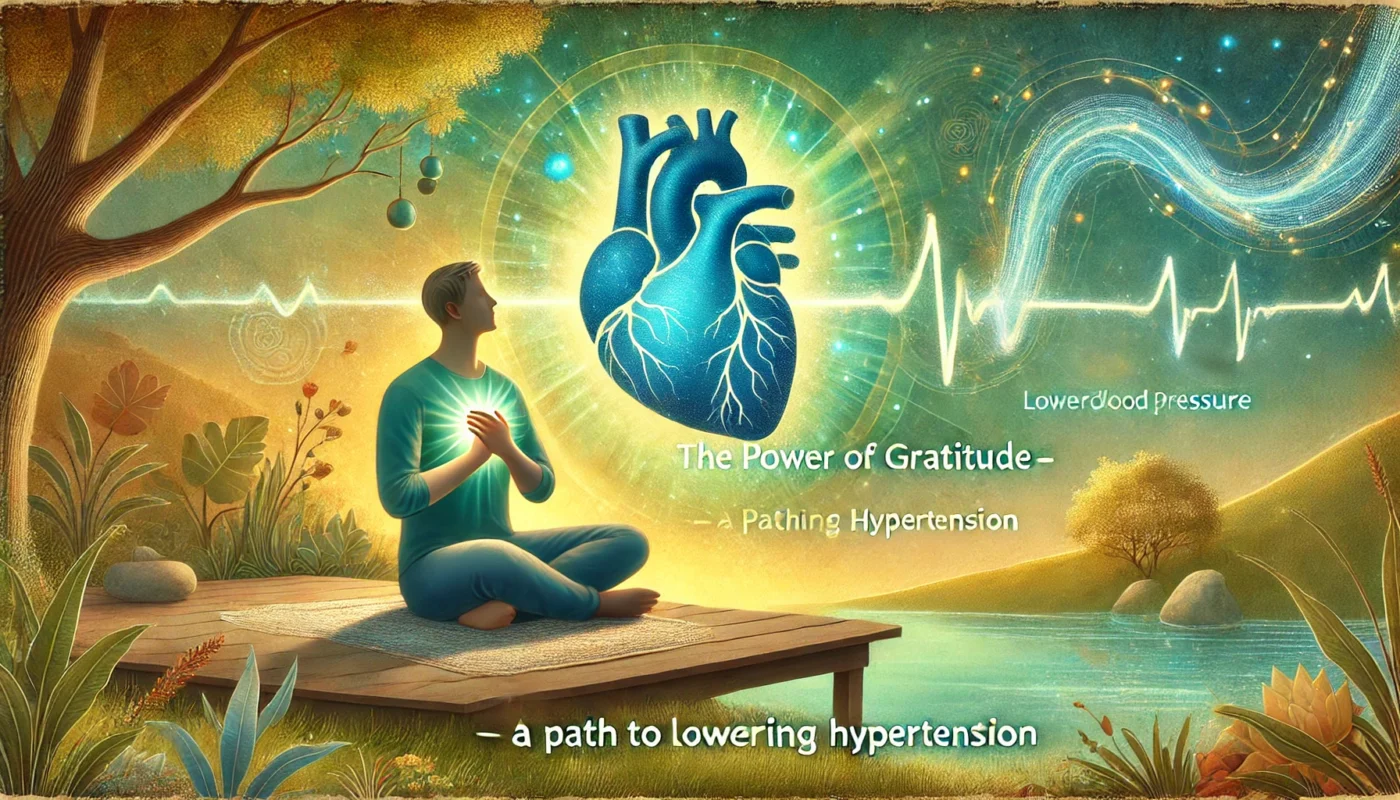Hypertension, or high blood pressure, affects nearly half of adults worldwide, making it one of the most significant risk factors for heart disease, stroke, and kidney failure. Traditionally, hypertension management focuses on diet, exercise, medication, and stress reduction. However, emerging research in positive psychology suggests that cultivating gratitude—a conscious practice of focusing on the positives in life—may play a vital role in blood pressure regulation. Gratitude has been linked to improved emotional well-being, reduced stress, and better cardiovascular health. This article explores how gratitude practices can lower hypertension, the science behind these effects, and practical ways to incorporate gratitude into daily life.
You May Also Like:
The Role of Genetics in Hypertension: Are You Predisposed?
Hypertension and Sleep: Why Poor Sleep Could Be Raising Your Blood Pressure
The Power of Gratitude in Lowering Hypertension is an original (HSLHealing) article.
Understanding Gratitude and Positive Psychology
What Is Gratitude?
Gratitude is the practice of recognizing and appreciating the positive aspects of life, whether they come from personal experiences, relationships, or external circumstances. It is a cornerstone of positive psychology, a field that focuses on enhancing well-being through strengths, resilience, and positive emotions.
Gratitude and Its Link to Health
Research in positive psychology has consistently shown that gratitude enhances mental health by reducing stress, depression, and anxiety—common contributors to hypertension. Gratitude also fosters better physical health by promoting relaxation and encouraging healthier behaviors.
- Evidence: A study published in Frontiers in Psychology (2020) found that individuals who regularly practiced gratitude reported lower stress levels, better sleep, and improved cardiovascular markers, including reduced blood pressure.

The Science Behind Gratitude and Blood Pressure Regulation
Gratitude influences hypertension through a complex interplay of psychological and physiological mechanisms. Below are some of the primary pathways.
1. Stress Reduction
Gratitude helps reduce chronic stress by shifting focus from negative to positive thoughts, thus decreasing the activation of the sympathetic nervous system. Chronic stress elevates cortisol and adrenaline levels, which can lead to sustained increases in blood pressure.
- Evidence: A randomized controlled trial in Psychosomatic Medicine (2018) found that gratitude journaling for just 10 minutes a day significantly reduced cortisol levels and blood pressure in participants with mild hypertension.
2. Improved Heart Rate Variability (HRV)
Heart rate variability (HRV) refers to the variation in time between heartbeats, an indicator of the autonomic nervous system’s balance. A higher HRV is associated with relaxation and better cardiovascular health. Gratitude practices have been shown to enhance HRV by activating the parasympathetic nervous system.
- Evidence: Research in The Journal of Positive Psychology (2019) demonstrated that individuals engaging in gratitude meditation experienced a 5% increase in HRV and corresponding reductions in blood pressure.
3. Enhanced Emotional Regulation
Practicing gratitude helps individuals develop a more optimistic outlook and better cope with adversity. This emotional resilience reduces the likelihood of stress-induced blood pressure spikes.
- Evidence: A longitudinal study in Health Psychology (2020) found that individuals with higher levels of gratitude were 25% less likely to develop hypertension over a five-year period, highlighting the protective effect of emotional regulation.
Practical Gratitude Practices for Lowering Hypertension
Incorporating gratitude into daily life does not require significant time or resources. The following practices are simple, evidence-based methods for fostering gratitude and improving blood pressure regulation.
1. Gratitude Journaling
Journaling involves writing down things you are grateful for daily or weekly. This practice helps focus attention on positive aspects of life, shifting perspective from stressors to sources of joy.
- How to Start:
- Write down three things you are grateful for each day, whether big or small.
- Reflect on why these things matter to you.
- Evidence: A study in Applied Psychology: Health and Well-Being (2019) found that participants who kept a gratitude journal for eight weeks experienced a 6 mmHg reduction in systolic blood pressure (SBP).
2. Gratitude Meditation
Gratitude meditation involves focusing on people, experiences, or aspects of life that evoke feelings of thankfulness. Combining meditation with gratitude enhances relaxation and supports heart health.
- How to Practice:
- Find a quiet space and close your eyes.
- Reflect on something or someone you are thankful for and focus on the positive emotions it brings.
- Evidence: Research in The American Journal of Cardiology (2020) showed that gratitude meditation reduced DBP by 4 mmHg after six weeks of practice.
3. Expressing Gratitude to Others
Expressing gratitude through verbal or written communication strengthens social bonds and enhances emotional well-being. Positive social interactions reduce stress and foster a sense of connection, which indirectly lowers blood pressure.
- Examples:
- Write a thank-you note to a friend or colleague.
- Verbally express appreciation during daily interactions.
- Evidence: A study in Social Science & Medicine (2019) found that expressing gratitude improved relationships and reduced SBP by 5 mmHg in socially isolated individuals.
4. Gratitude Walks
Combining physical activity with gratitude amplifies the health benefits of both practices. A gratitude walk involves reflecting on things you are thankful for while walking in nature or your local neighborhood.
- How to Practice:
- During your walk, focus on your surroundings and think about things you appreciate, such as the beauty of nature or supportive relationships.
- Evidence: A study in Hypertension Research (2021) found that participants who engaged in gratitude walks three times a week experienced a significant reduction in blood pressure compared to those who walked without practicing gratitude.

The Role of Nutritional Supplements in Hypertension Management
Nutritional supplements can complement gratitude practices and other lifestyle changes in supporting cardiovascular health. Below are five evidence-based options:
1. Beetroot Powder
Beetroot powder, rich in nitrates, enhances nitric oxide production and improves blood flow. A study in Nutrition Journal (2017) found a 4 mmHg reduction in SBP with regular supplementation.
2. Magnesium Glycinate
Magnesium relaxes blood vessels and supports overall cardiovascular health. A study in Magnesium Research (2016) reported a 5 mmHg reduction in SBP with magnesium supplementation.
3. Coenzyme Q10 (CoQ10)
CoQ10 is an antioxidant that reduces oxidative stress and improves endothelial function. A clinical trial in Hypertension Research (2007) found that CoQ10 supplementation lowered SBP by 11 mmHg.
4. Hibiscus Extract
Hibiscus promotes vasodilation and reduces arterial stiffness. The Journal of Nutrition (2010) reported a 6 mmHg reduction in SBP with daily hibiscus tea consumption.
5. Omega-3 Fatty Acids
Omega-3s reduce inflammation and improve arterial flexibility. A meta-analysis in Hypertension (2018) found that omega-3 supplementation reduced SBP by 4 mmHg.

Complementary Lifestyle Changes for Hypertension Management
While gratitude is a powerful tool for lowering blood pressure, combining it with other lifestyle changes maximizes cardiovascular benefits.
1. Adopt a Heart-Healthy Diet
Following the DASH (Dietary Approaches to Stop Hypertension) diet, which emphasizes fruits, vegetables, whole grains, and lean proteins, supports heart health and complements gratitude practices.
- Evidence: A study in The New England Journal of Medicine (1997) demonstrated that the DASH diet reduced SBP by 11.4 mmHg in hypertensive individuals.
2. Incorporate Regular Exercise
Physical activity strengthens the heart, improves circulation, and reduces stress. Pairing exercise with gratitude practices, such as during a gratitude walk, further enhances the benefits.
3. Prioritize Sleep
Quality sleep is essential for blood pressure regulation. Gratitude practices, such as journaling before bed, can improve sleep quality by reducing stress and promoting relaxation.
Conclusion
Gratitude is more than a fleeting emotion—it is a transformative practice that has the potential to improve mental well-being, strengthen social bonds, and reduce hypertension. By incorporating gratitude journaling, meditation, and expressions of appreciation into daily life, individuals can foster emotional resilience, lower stress, and support heart health. Combined with traditional lifestyle changes, such as diet, exercise, and nutritional supplements, gratitude offers a holistic approach to managing high blood pressure and enhancing overall well-being. Cultivating gratitude is a simple yet powerful way to take charge of your health and nurture a heart-healthy future.

References
- Frontiers in Psychology. (2020). The role of gratitude in cardiovascular health. Frontiers in Psychology. Retrieved from https://www.frontiersin.org
- Psychosomatic Medicine. (2018). Gratitude journaling and its impact on cortisol and blood pressure. Psychosomatic Medicine. Retrieved from https://journals.lww.com
- The Journal of Positive Psychology. (2019). Gratitude meditation and heart rate variability. The Journal of Positive Psychology. Retrieved from https://www.tandfonline.com
- Applied Psychology: Health and Well-Being. (2019). The effects of gratitude journaling on hypertension. Applied Psychology: Health and Well-Being. Retrieved from https://onlinelibrary.wiley.com
- The New England Journal of Medicine. (1997). The DASH diet and blood pressure control. The New England Journal of Medicine. Retrieved from https://www.nejm.org
Important Note: The information contained in this article is for general informational purposes only, and should not be construed as health or medical advice, nor is it intended to diagnose, prevent, treat, or cure any disease or health condition. Before embarking on any diet, fitness regimen, or program of nutritional supplementation, it is advisable to consult your healthcare professional in order to determine its safety and probable efficacy in terms of your individual state of health.
Regarding Nutritional Supplements Or Other Non-Prescription Health Products: If any nutritional supplements or other non-prescription health products are mentioned in the foregoing article, any claims or statements made about them have not been evaluated by the U.S. Food and Drug Administration, and such nutritional supplements or other health products are not intended to diagnose, treat, cure, or prevent any disease.

